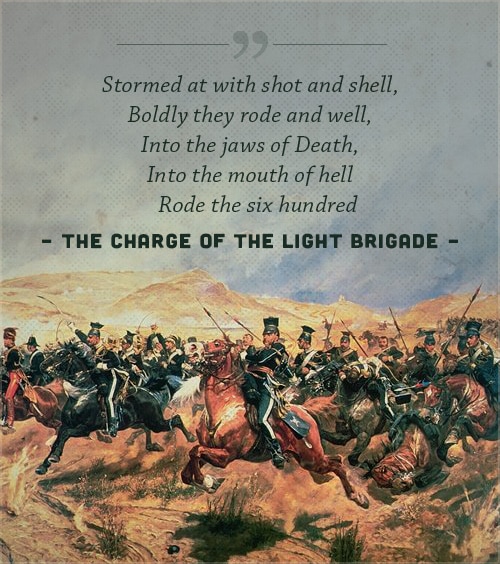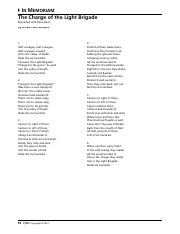

His first poems were published in 1827 when he left home to attend Trinity College, Cambridge, with his brothers. Yet the poem represents the observers of the action as unified in their response: "All the world wondered. Certainly, the economic prosperity and optimism of the mid-Victorian age would have led readers to the interpretation that military commanders and soldiers fought together as a unit. Taking part in the charge were 17 men listed as trumpeters on the muster rolls.


Charge for the guns! Why do you suppose Tennyson has repeated canon at the beginning six lines stanzas three and five? Theirs not to make reply, Theirs not to reason why, Theirs but to do and die. However, for Tennyson and most of his contemporaries, the war seemed necessary and just. Tennyson remained the foremost Victorian poet until his death in 1892. But what, my Lord, was the feeling and what the bearing of those brave men who returned to the position. Tens of thousands of soldiers died during the "The Charge of the Light Brigade" is one of Tennyson's most famous poems, but it does not compare in terms of length or ambition to his more critically acclaimed works such as "In Memoriam, A. The Charge of the Light Brigade by Alfred, Lord Tennyson Summary, Analysis and Questions Answers » Smart English Notes Through its vivid descriptions and heroic themes, the poem captures the drama and emotion of the charge, and celebrates the bravery of the soldiers who rode "into the jaws of Death, / Into the mouth of Hell." Overall, The Charge of the Light Brigade is a powerful and moving poem that pays tribute to the bravery and sacrifice of British soldiers during the Crimean War. The final stanza concludes the poem by reaffirming the heroism and bravery of the soldiers, as the speaker declares that they "were the few, / We are the many." This stanza serves as a tribute to the soldiers and their sacrifice, as it honors their memory and celebrates their bravery. The stanza asks, "When can their glory fade?" and concludes that the soldiers' bravery will be remembered "for aye." The fifth stanza shifts to a more reflective tone, as the speaker reflects on the meaning and significance of the charge. The fourth stanza describes the aftermath of the charge, as the soldiers return "back from the mouth of Hell," with "not a one was missing." Despite the heroism and bravery of the soldiers, the stanza also hints at the cost of the charge, as it notes that "their faces were gory." The third stanza describes the actual charge itself, as the soldiers ride "all in the valley of Death / Rode the six hundred." The stanza describes the chaos and violence of the charge, as the soldiers are "stormed at with shot and shell," and "boldly they rode and well." The second stanza describes the command given to the soldiers to charge, and how they "rode straight into the face of fire." This stanza also introduces the idea of confusion and misunderstanding, as the soldiers are ordered to charge "into the valley of Death" but are not told why. The first stanza introduces the theme of the poem, as the speaker describes the charge as a "noble six hundred" of soldiers who rode "into the jaws of Death, / Into the mouth of Hell." This sets the stage for the heroic and daring nature of the charge, which is described in the subsequent stanzas.
CHARGE OF THE LIGHT BRIGADE POEM ANALYSIS SERIES
The poem is structured as a series of six stanzas, each of which describes a different aspect of the charge.

It tells the story of a military charge made by British cavalry soldiers during the Crimean War against Russia. The Charge of the Light Brigade is a famous poem written by Alfred, Lord Tennyson in 1854.


 0 kommentar(er)
0 kommentar(er)
